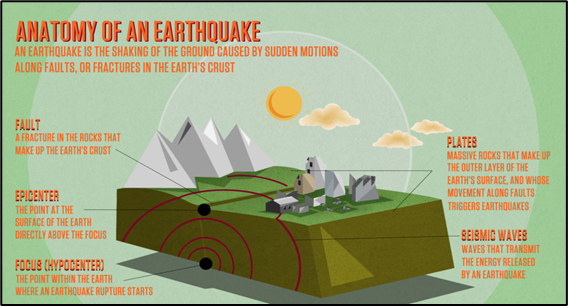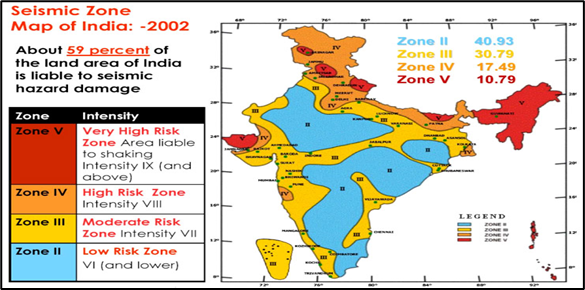Why in News?
- Tremors lasting several seconds were felt in Delhi and other parts of North India as a strong 6.5-magnitude earthquake struck Afghanistan recently.
What’s in Today’s Article?
- What is an Earthquake?
- What are the Earthquake High Risk Zones in India?
- How Big is the Earthquake in Afghanistan?
What is an Earthquake?
- An earthquake is an intense shaking of the ground caused by movement under the earth’s surface.
- The location below the earth’s surface where the earthquake starts is called the
- The location directly above the hypocentre on the surface of the earth is called the epicentre.
- It happens when two blocks (tectonic plates) of the earth suddenly slip past one another releasing stored-up ‘elastic strain’ energy in the form of seismic waves.
- These spread through the earth and cause the shaking of the ground.
- They are measured on scales called the -
- Moment Magnitude Scale (Mw), based on the total moment (a product of the distance a fault moved and the force required to move it) release of the earthquake.
- The Richter scale (magnitude scale) - energy released - 0-10.
- The intensity scale/Mercalli scale - visible damage - 1-12.
- Earthquakes continue to remain the most common natural hazard that cannot be predicted as no early warning systems can be developed.

What are the Earthquake High Risk Zones in India?
- Western Himalayas continue to be one of the most dangerous seismic zones in the world.
- According to the scientists, the Himalayan region - the 2500-km stretch from the Hindu Kush mountains to the end of Arunachal Pradesh - is due for a big earthquake (magnitude of over 8 on Richter scale) anytime.
- This is because of the huge amount of energy stored along the fault lines due to the continuous interaction of different tectonic plates.
- This energy can be released only in the form of massive earthquakes.

How Big is the Earthquake in Afghanistan?
- The earthquake was deep (origin 187.6 km below the earth’s surface) and the epicentre of the earthquake was in northeastern Afghanistan (earthquake prone Hindu Kush region), close to Tajikistan borders.
- Shallow earthquakes are generally more devastating because they carry greater energy when they emerge on the surface.
- Deeper earthquakes lose much of their energy by the time they come to the surface - cause less damage and are more unlikely to be followed by
- However, they spread farther as the seismic waves move radially upwards to the surface.
- That is why the tremors were experienced in Punjab, Rajasthan’s Jaipur, and J&K, however, no damage is reported in India.
- This earthquake was of 5-magnitude.
- Magnitude is a measure of how big the waves are, while the strength refers to the energy it carries.
- Magnitude 6 earthquakes have 10 times higher amplitude than magnitude 5 earthquakes. The energy differential is even higher, 32 times for every change of 1 in magnitude.











